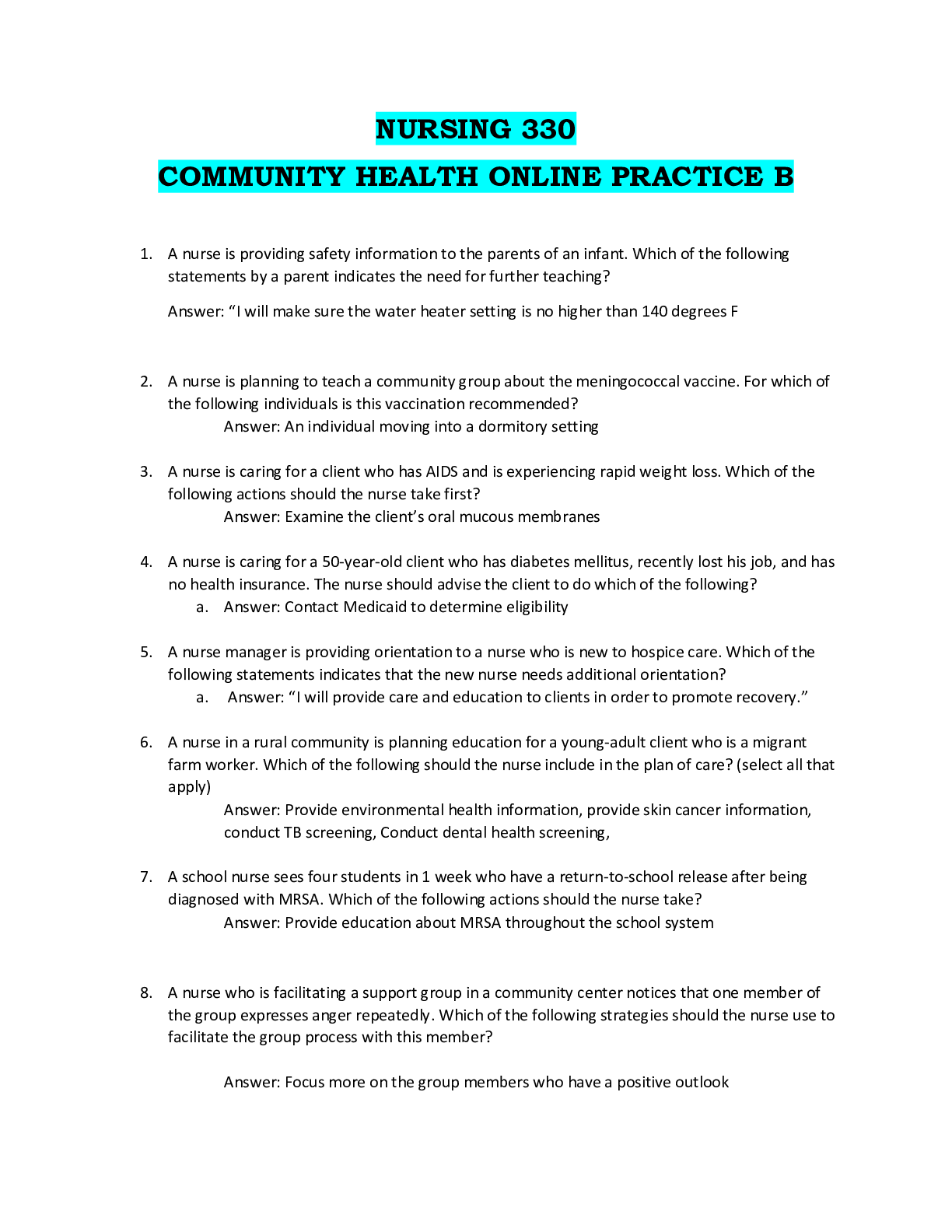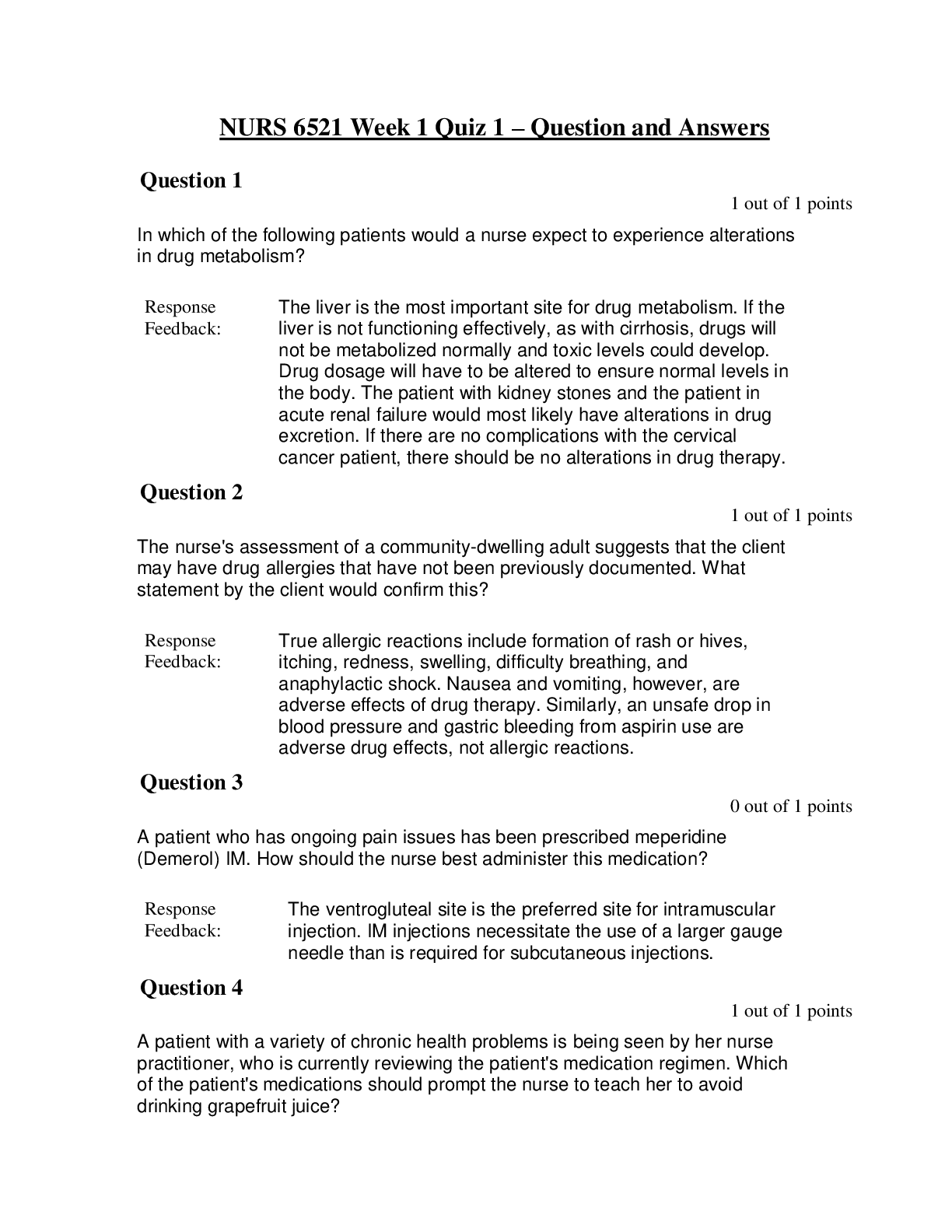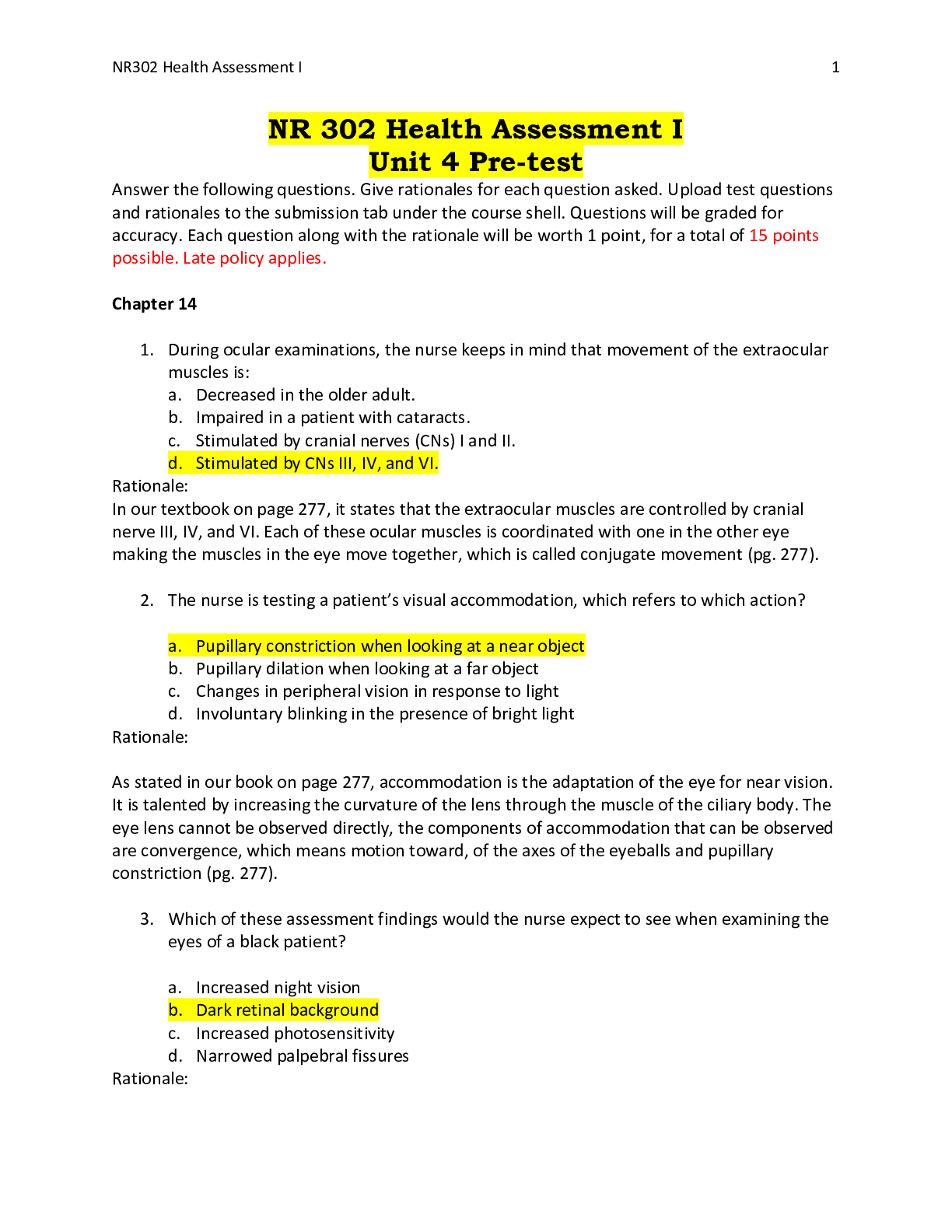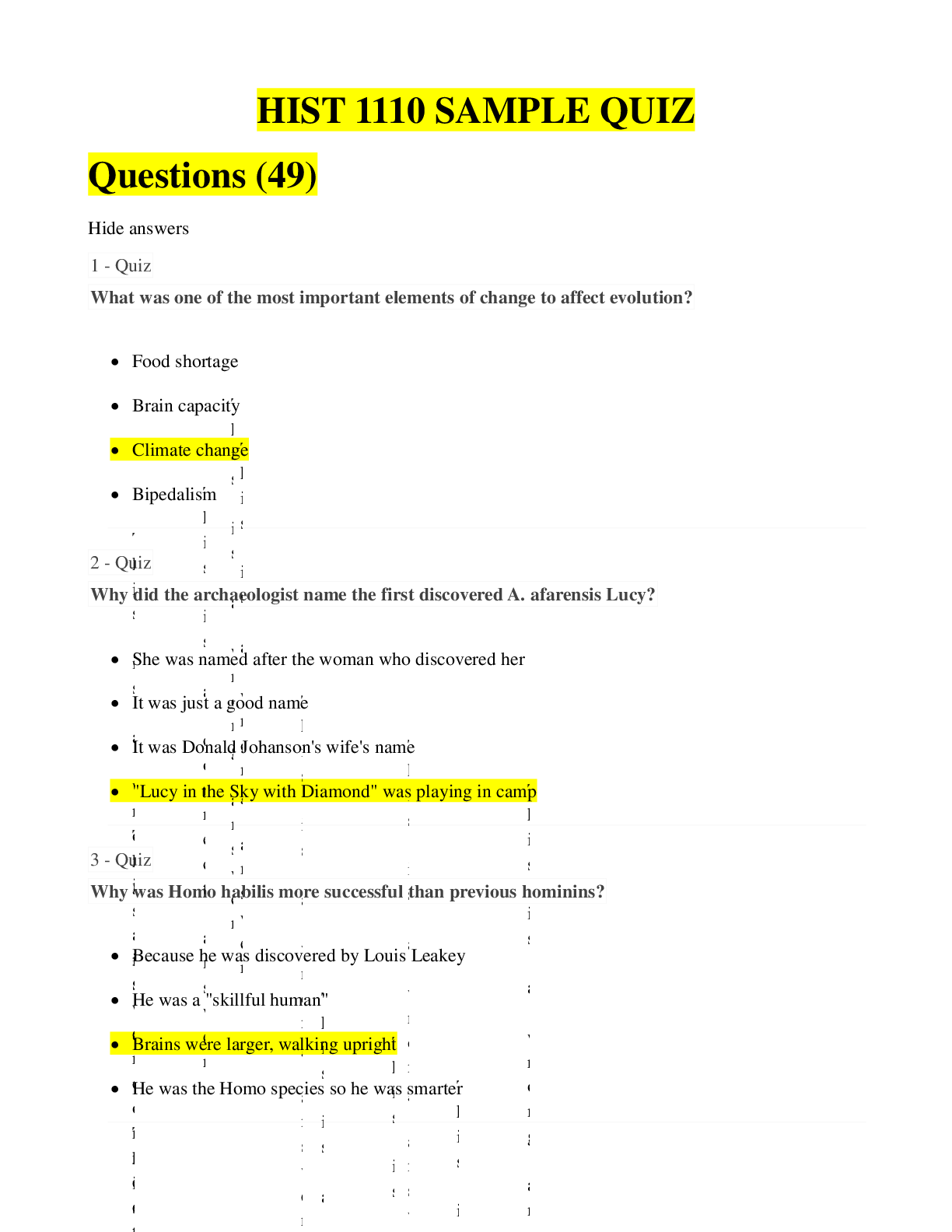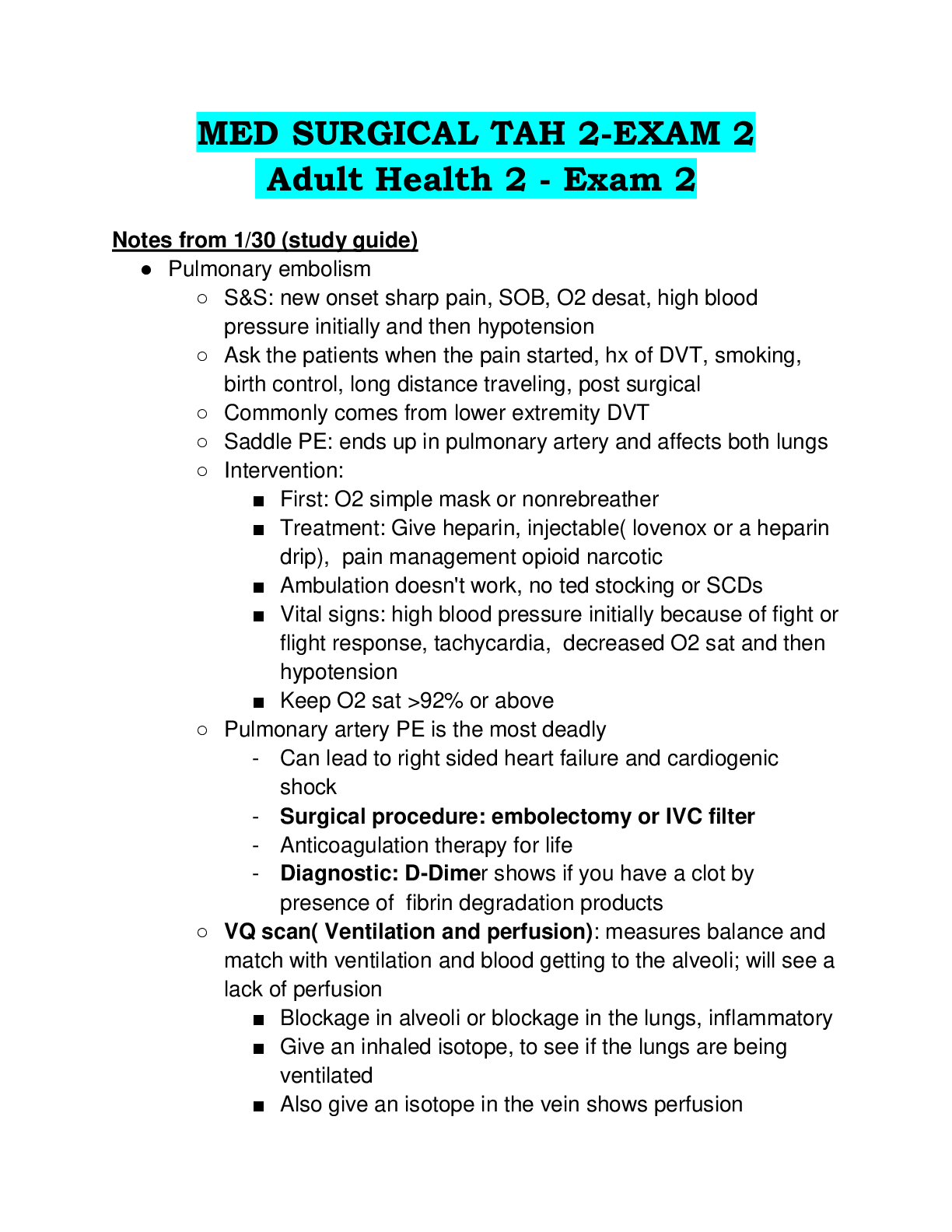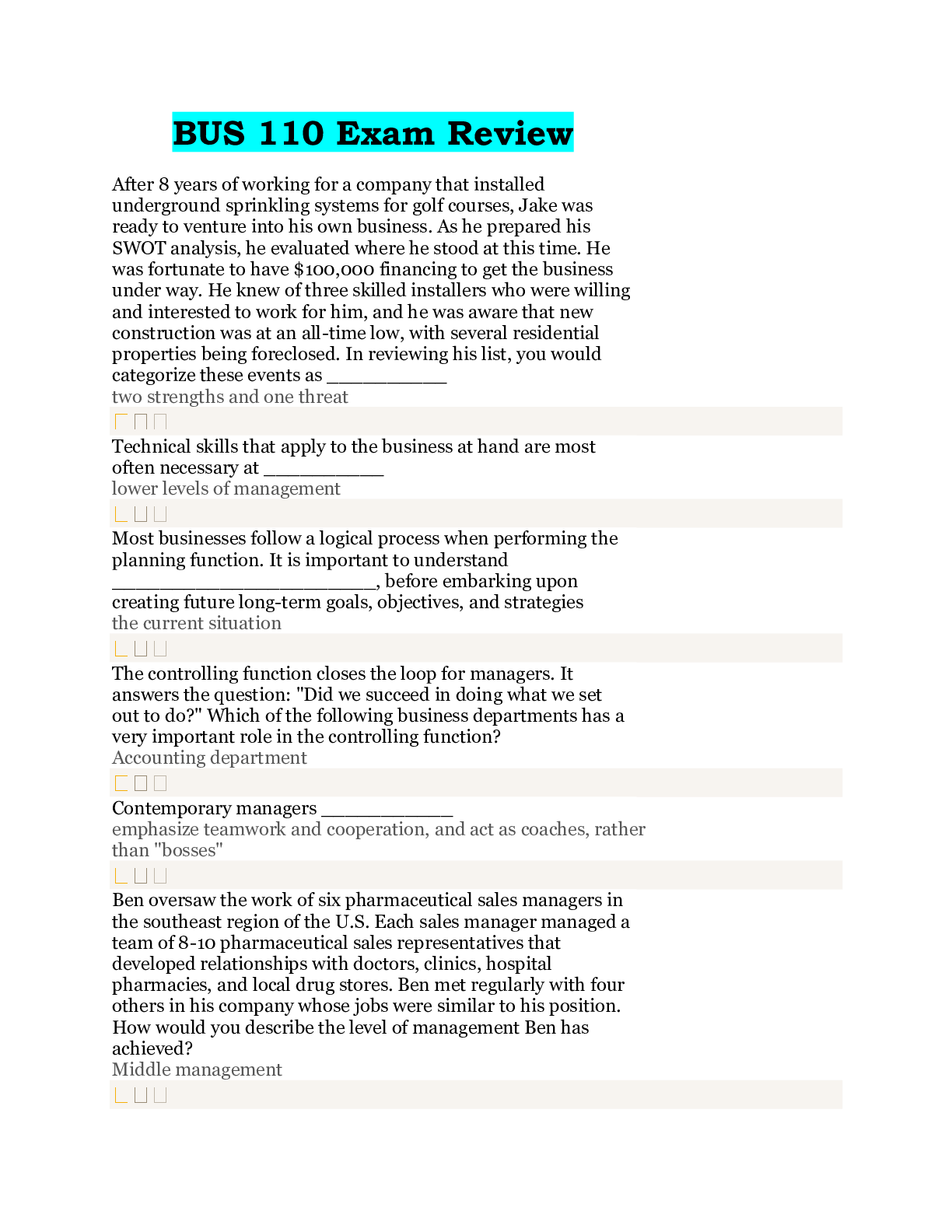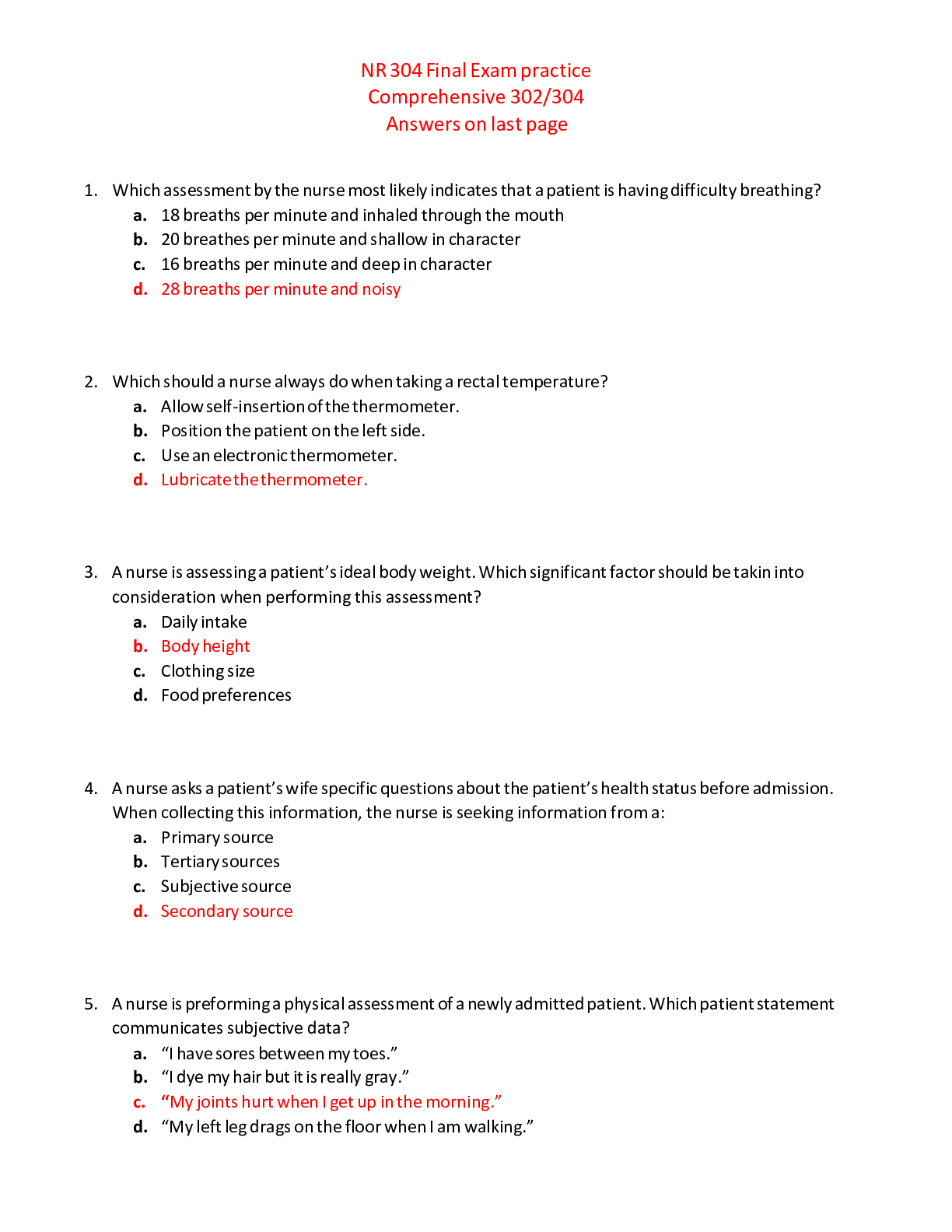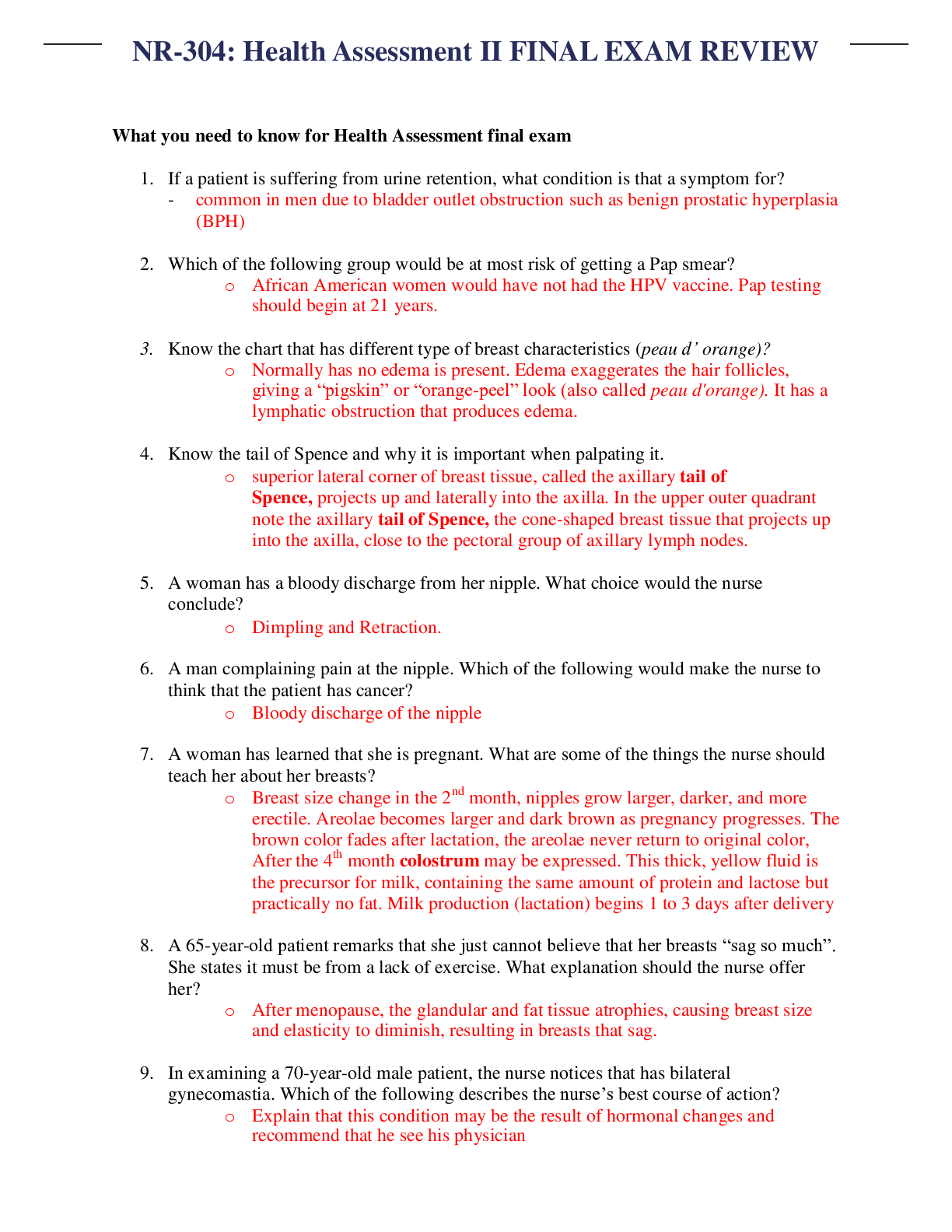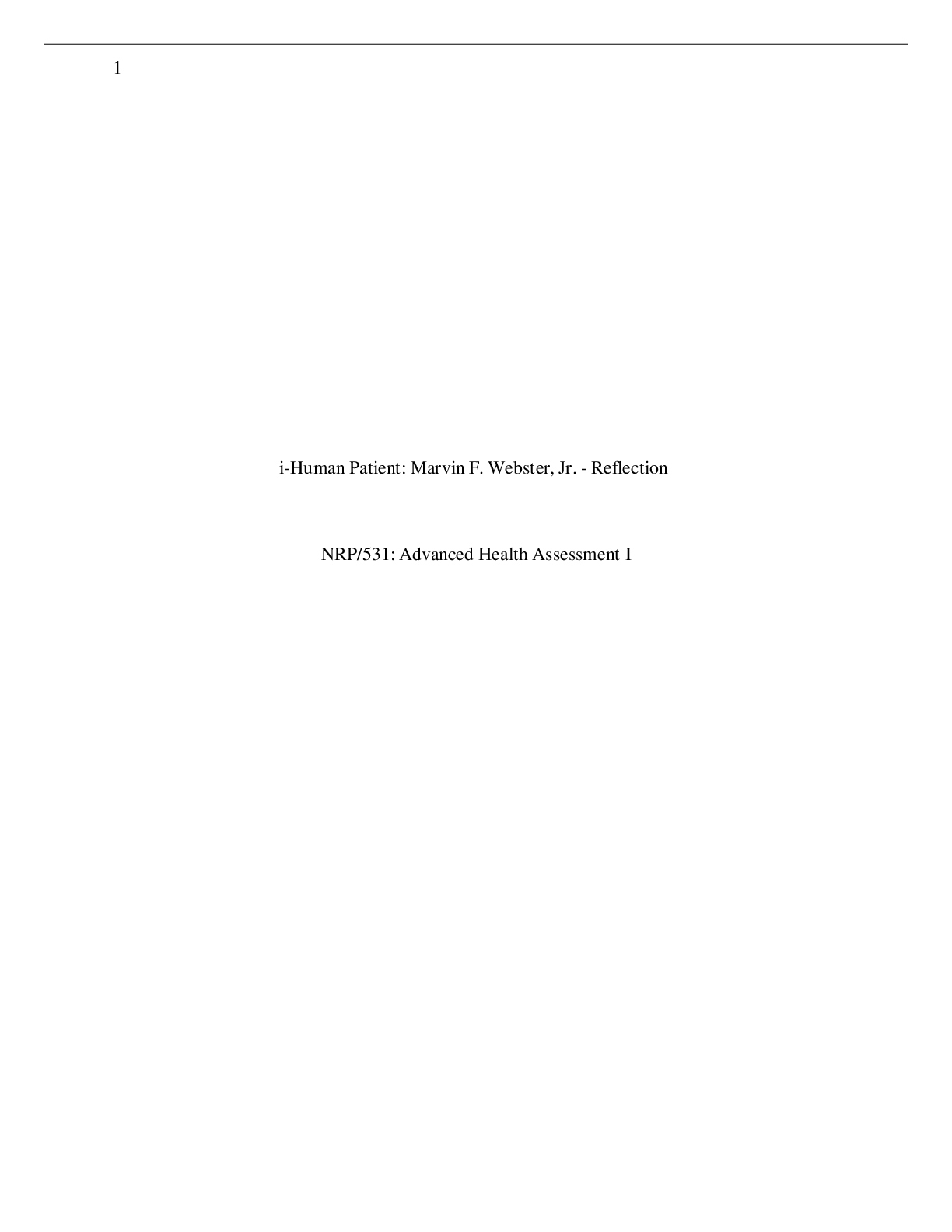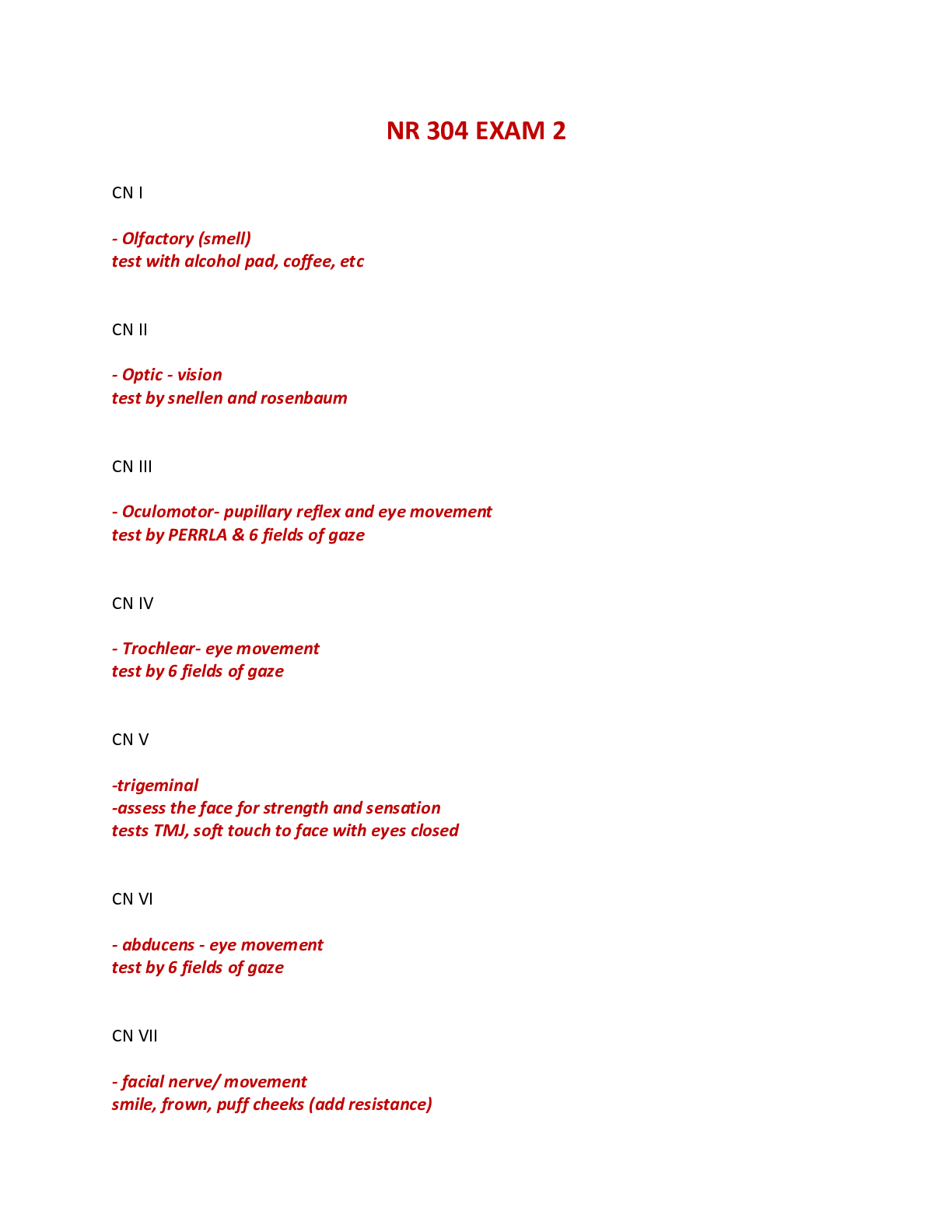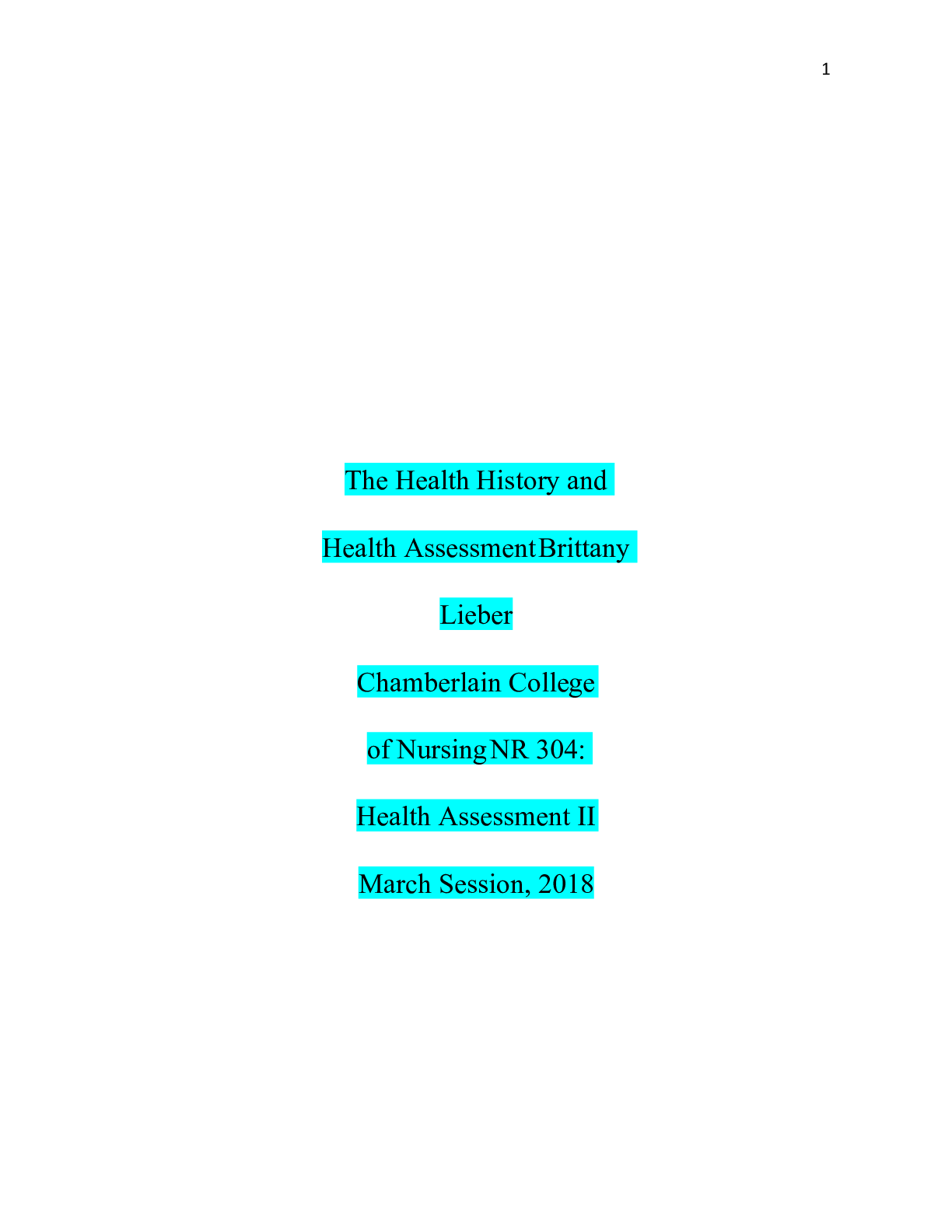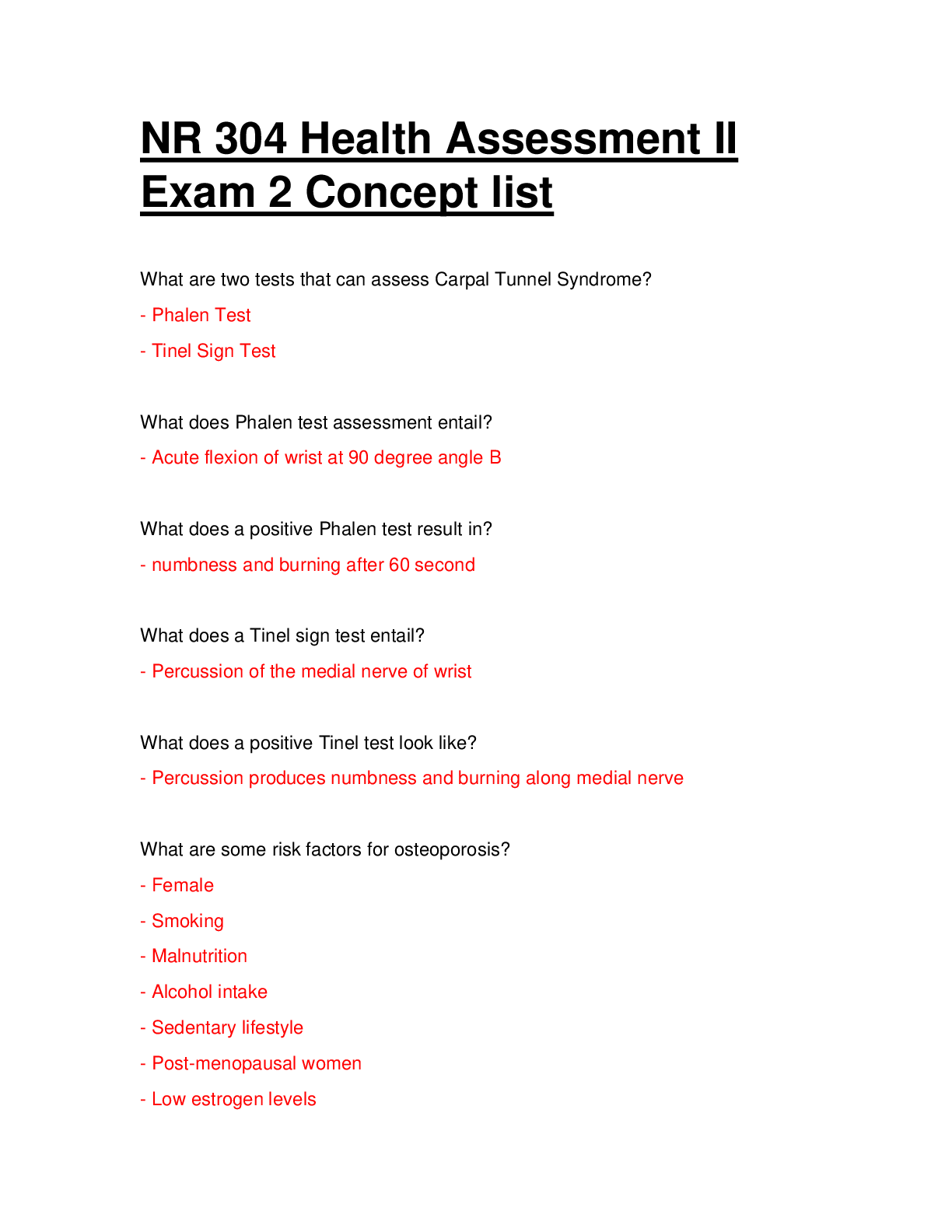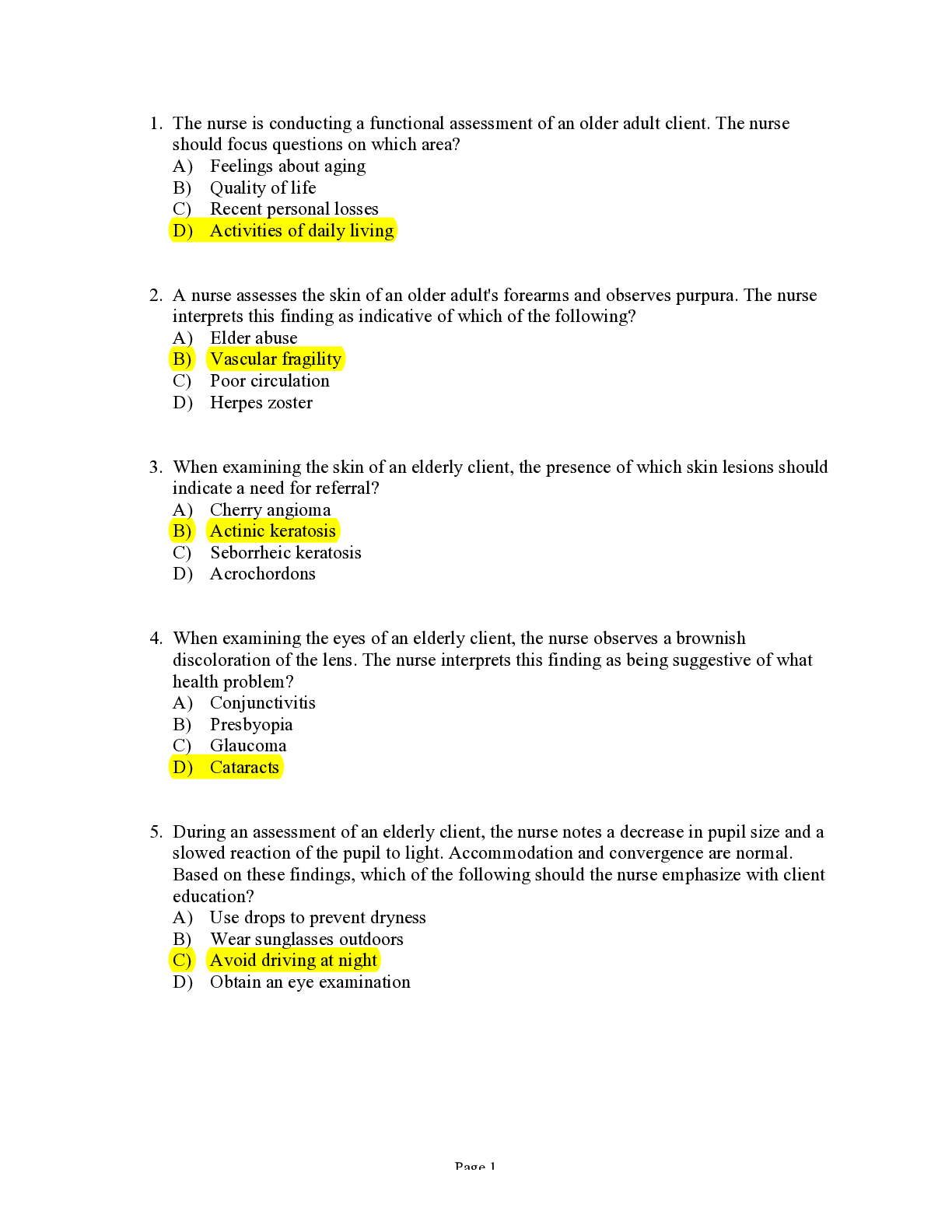NR 302 Health Assessment I Unit 5 Pre-test
Document Content and Description Below
NR 302 Health Assessment I 1 NR 302 Health Assessment I Unit 5 Pre-test Answer the following questions. Give rationales for each question asked. Upload test questions and rationales to the submiss... ion tab under the course shell. Questions will be graded for accuracy. 1. When performing a respiratory assessment on a patient, the nurse notices a costal angle of approximately 90 degrees. This characteristic is: a. Observed in patients with kyphosis. b. Indicative of pectus excavatum. c. A normal finding in a healthy adult. d. An expected finding in a patient with a barrel chest. Rationale: The right and left costal margins form an angle where they meet at the xiphoid process. Usually 90 degrees or less, this angle increases when the rib cage is chronically overinflated, as in emphysema (pg. 405). Since this patient has a costal angle of approximately 90%, this characteristic should be noted as a normal finding. 2. When assessing a patient’s lungs, the nurse recalls that the left lung: a. Consists of two lobes. b. Is divided by the horizontal fissure. c. Primarily consists of an upper lobe on the posterior chest. d. Is shorter than the right lung because of the underlying stomach. Rationale: In the beginning of chapter 19’s chapter, the book talks about the anatomy of the respiratory system and says, the right lung consists of 3 lobes and the left lung consists of 2 (pg. 407). 3. During an assessment, the nurse knows that expected assessment findings in the normal adult lung include the presence of: a. Adventitious sounds and limited chest expansion. b. Increased tactile fremitus and dull percussion tones. c. Muffled voice sounds and symmetric tactile fremitus. d. Absent voice sounds and hyperresonant percussion tones. Rationale: When assessing your patient, you want to confirm symmetric chest expansion by placing your warmed hands sideways on the posterolateral chest wall with thumbs pointing together at the level of T9 or T 10, slide your hands medially to pinch up a small fold of skin between your thumbs. When assessing your patient’s tactile fremitus, you are assessing your patient’s vibration. Lastly, normal voice transmission is soft, muffles, and indistinct; you can hear sound through the stethoscope but cannot distinguish exactly what is being said (pg. 424). 4. A 65-year-old patient with a history of heart failure comes to the clinic with complaints of “being awakened from sleep with shortness of breath.” Which action by the nurse is most appropriate? a. Obtaining a detailed health history of the patient’s allergies and a history of asthma b. Telling the patient to sleep on his or her right side to facilitate ease of respirationsNR 302 Health Assessment I 2 c. Assessing for other signs and symptoms of paroxysmal nocturnal dyspnea d. Assuring the patient that paroxysmal nocturnal dyspnea is normal and will probably resolve within the next week Rationale: On pg. 413 in our textbook, they define paroxysmal nocturnal dyspnea as when you are awakening from sleep with SOB and needed to be upright to achieve comfort. 5. The nurse is reviewing the technique of palpating for tactile fremitus with a new graduate. Which statement by the graduate nurse reflects a correct understanding of tactile fremitus? “Tactile fremitus: a. “Is caused by moisture in the alveoli.” b. “Indicates that air is present in the subcutaneous tissues.” c. “Is caused by sounds generated from the larynx.” d. “Reflects the blood flow through the pulmonary arteries.” Rationale: Our textbook does a good job explaining this process. Fremitus is a palpable vibration. Sounds generated from the larynx are transmitted through patient bronchi and the lung parenchyma to the chest wall, which is where you will feel the vibrations (pg. 417). 6. The nurse is observing the auscultation technique of another nurse. The correct method to use when progressing from one auscultatory site on the thorax to another is _______ comparison. a. Side-to-side b. Top-to-bottom c. Posterior-to-anterior d. Interspace-by-interspace Rationale: Our textbook says to determine the predominant note over the lung fields. Start at the apices and percuss the band or normally resonant tissue across the tops of both shoulders. Then, percussing in the interspaces, make a side-to-side comparison all the wat down the lung region. Percuss at 5- cm intervals (pg. 419). 7. The nurse is auscultating the chest in an adult. Which technique is correct? a. Instructing the patient to take deep, rapid breaths b. Instructing the patient to breathe in and out through his or her nose c. Firmly holding the diaphragm of the stethoscope against the chest d. Lightly holding the bell of the stethoscope against the chest to avoid friction Rationale: As stated in our textbook, the correct way to auscultate breath sounds is to use the diaphragm of the stethoscope help firmly against the chest (pg. 426). 8. During auscultation of the lungs, the nurse expects decreased breath sounds to be heard in which situation? a. When the bronchial tree is obstructed b. When adventitious sounds are present c. In conjunction with whispered pectoriloquy d. In conditions of consolidation, such as pneumoniaNR 302 Health Assessment I 3 Rationale: Decreased or absent breath sounds occur when the bronchial tree is obstructed, as in emphysema, and when sound transmission is obstructed, as in pleurisy, pneumothorax, or pleural effusion (pg. 421). 9. A mother brings her 3-month-old infant to the clinic for evaluation of a cold. She tells the nurse that he has had “a runny nose for a week.” When performing the physical assessment, the nurse notes that the child has nasal flaring and sternal and intercostal retractions. The nurse’s next action should be to: a. Assure the mother that these signs are normal symptoms of a cold. b. Recognize that these are serious signs and contact the physician. c. Ask the mother if the infant has had trouble with feedings. d. Perform a complete cardiac assessment because these signs are probably indicative of early heart failure. Rationale: Infants are typically obligatory nose breather until the age of 3 months. Normally there is no flaring of the nostrils and no sterna or intercostal retraction. Marked retractions of the sternum and intercostal muscles and nasal flaring indicate increased inspiratory effort, as in pneumonia, acute airway obstruction, asthma, and atelectasis; therefore, immediate referral to the physician is warranted. These signs do not indicate heart failure, and assessment of the infant’s feeding is not a priority at this time (pg. 427). 10. When inspecting the anterior chest of an adult, the nurse should include which assessment? a. Diaphragmatic excursion b. Symmetric chest expansion c. Presence of breath sounds d. Shape and configuration of the chest wall Rationale: As we have learned in our health assessment course, inspection of the anterior chest includes shape and configuration of the chest wall; assessment of the patient’s level of consciousness, skin color and condition; quality of respirations; presence or absence of retraction and bulging of the intercostal spaces; and use of accessory muscles. Symmetric chest expansion is assessed by palpation. Diaphragmatic excursion is assessed by percussion of the posterior chest. Breath sounds are assessed by auscultation (pg. 424). 11. The nurse is reviewing the characteristics of breath sounds. Which statement about bronchovesicular breath sounds is true? Bronchovesicular breath sounds are: a. Musical in quality. b. Usually caused by a pathologic disease. c. Expected near the major airways. d. Similar to bronchial sounds except shorter in duration. Rationale: Bronchovesicular sounds are heard over major bronchi where fewer alveoli are located: Posteriorly, between the scapulae, especially on the right; anteriorly, around the upper sternum in the first and second intercostal spaces (425). 12. The nurse is listening to the breath sounds of a patient with severe asthma. Air passing through narrowed bronchioles would produce which of these adventitious sounds?NR 302 Health Assessment I 4 a. Wheezes b. Bronchial sounds c. Bronchophony d. Whispered pectoriloquy Rationale: Wheezing is caused by air squeezed or compressed through passageways narrowed almost to closure by collapsing, swelling, secretions, or tumors, such as with acute asthma or chronic emphysema (pg. 439). 13. A teenage patient comes to the emergency department with complaints of an inability to breathe and a sharp pain in the left side of his chest. The assessment findings include cyanosis, tachypnea, tracheal deviation to the right, decreased tactile fremitus on the left, hyperresonance on the left, and decreased breath sounds on the left. The nurse interprets that these assessment findings are consistent with: a. Bronchitis. b. Pneumothorax. c. Acute pneumonia. d. Asthmatic attack. Rationale: During a pneumothorax, free air in the pleural space causes partial or complete lung collapse. If the pneumothorax is large, then tachypnea and cyanosis are seen. Unequal chest expansion, hyperresonant percussion tones, and decreased or absent breath sounds are found with the presence of pneumothorax (pg. 439). 14. An adult patient with a history of allergies comes to the clinic complaining of wheezing and difficulty in breathing when working in his yard. The assessment findings include tachypnea, the use of accessory neck muscles, prolonged expiration, intercostal retractions, decreased breath sounds, and expiratory wheezes. The nurse interprets that these assessment findings are consistent with: a. Asthma. b. Atelectasis. c. Lobar pneumonia. d. Heart failure. Rationale: Asthma is allergic hypersensitivity to certain inhaled particles that produces inflammation and a reaction of bronchospasm, which increases airway resistance, especially during expiration. Increased respiratory rate, use of accessory muscles, retraction of intercostal muscles, prolonged expiration, decreased breath sounds, and expiratory wheezing are all characteristics of asthma (439). 15. A 35-year-old recent immigrant is being seen in the clinic for complaints of a cough that is associated with rust-colored sputum, low-grade afternoon fevers, and night sweats for the past 2 months. The nurse’s preliminary analysis, based on this history, is that this patient may be suffering from: a. Bronchitis. b. Pneumonia.NR 302 Health Assessment I 5 c. Tuberculosis. d. Pulmonary edema. Rationale: Sputum is not diagnostic alone, but some conditions have the characteristics of sputum production. TB often produces rust colored sputum in addition to other symptoms of night sweats and low grade afternoon fevers (439). 16. During auscultation of breath sounds, the nurse should correctly use the stethoscope in which of the following ways? a. Listening to at least one full respiration in each location b. Listening as the patient inhales and then going to the next site during exhalation c. Instructing the patient to breathe in and out rapidly while listening to the breath sounds d. If the patient is modest, listening to sounds over his or her clothing or hospital gown Rationale: During auscultation of breath sounds with a stethoscope, it is important to listen to one full respiration in each location. During the examination, the nurse should monitor the breathing and offer times for the person to breathe normally to prevent possible dizziness (pg. 425). 17. During palpation of the anterior chest wall, the nurse notices a course, crackling sensation over the skin surface. On the basis of these findings, the nurse suspects: a. Tactile fremitus. b. Crepitus. c. Friction rub. d. Adventitious sounds. Rationale: Crepitus is a course, cracking sensation palpable over the skin surface. It occurs in subcutaneous emphysema when air escapes from the lung and enters the subcutaneous tissue, as after open thoracic injury or surgery (pg. 418). 18. The nurse is auscultating the lungs of a patient who had been sleeping and notices short, popping, crackling sounds that stop after a few breaths. The nurse recognizes that these breath sounds are: a. Atelectatic crackles that do not have a pathologic cause. b. Fine crackles and may be a sign of pneumonia. c. Vesicular breath sounds. d. Fine wheezes. Rationale: One type of adventitious sounds, atelectatic crackles, is not pathogenic. They are short, popping, cracking sounds that sound like fine crackles but do not last beyond a few breaths. When sections of alveoli are not fully aerated, they deflate slightly and accumulate secretions. Crackles are heard when these sections are expanded by a few deep breaths. Atelectatic crackles are heard only in the periphery, usually in dependent proportions of the lungs, and disappear after the first few breaths or after a cough (pg. 423). 19. A patient with pleuritis has been admitted to the hospital and complains of pain with breathing. What other key assessment finding would the nurse expect to find upon auscultation? a. StridorNR 302 Health Assessment I 6 b. Friction rub c. Crackles d. Wheezing Rationale: A patient with pleuritis will exhibit a pleural friction rub upon auscultation. This is the sound made when pleurae become inflamed and rub together during respiration. The sound is superficial, coarse, and lowpitched, as if two pieces of leather are being rubbed together. Stridor is associated with croup, acute epiglottitis in children, and foreign body inhalation. Crackles are associated with several diseases, such as pneumonia, heart failure, chronic bronchitis, and others (pg. 439). 20. The nurse is assessing voice sounds during a respiratory assessment. Which of these findings indicates a normal assessment? Select all that apply. a. Voice sounds are faint, muffled, and almost inaudible when the patient whispers “one, two, three” in a very soft voice. b. As the patient repeatedly says “ninety-nine,” the examiner clearly hears the words “ninety-nine.” c. When the patient speaks in a normal voice, the examiner can hear a sound but cannot exactly distinguish what is being said. d. As the patient says a long “ee-ee-ee” sound, the examiner also hears a long “ee-ee-ee” sound. e. As the patient says a long “ee-ee-ee” sound, the examiner hears a long “aaaaaa” sound. Rationale: As you instruct the patient to say “ninety-nine” repeatedly, normally, the examiner hears the sound but cannot distinguish what is being said. If a clear “ninety-nine” us auscultated then it could indicate increased Luna density, which enhanced transmission of voice sounds. This is a measure of bronchophony. When a patient says a long "ee-ee-ee" sound, normally the examiner also hears a long "ee-ee-ee" sound through auscultation. This is a measure of egophony. If the examiner hears a long "aaaaaa" sound instead, this could indicate areas of consolidation or compression. With whispered pectoriloquy, as when a patient whispers a phrase such as "one-two-three," the normal response when auscultating voice sounds is to hear sounds that are faint, muffled, and almost inaudible. If the examiners hear the whispered voice clearly, as if the patient is speaking through the stethoscope, then consolidation of the lung fields may exist (pg. 417). [Show More]
Last updated: 1 year ago
Preview 1 out of 6 pages
Instant download
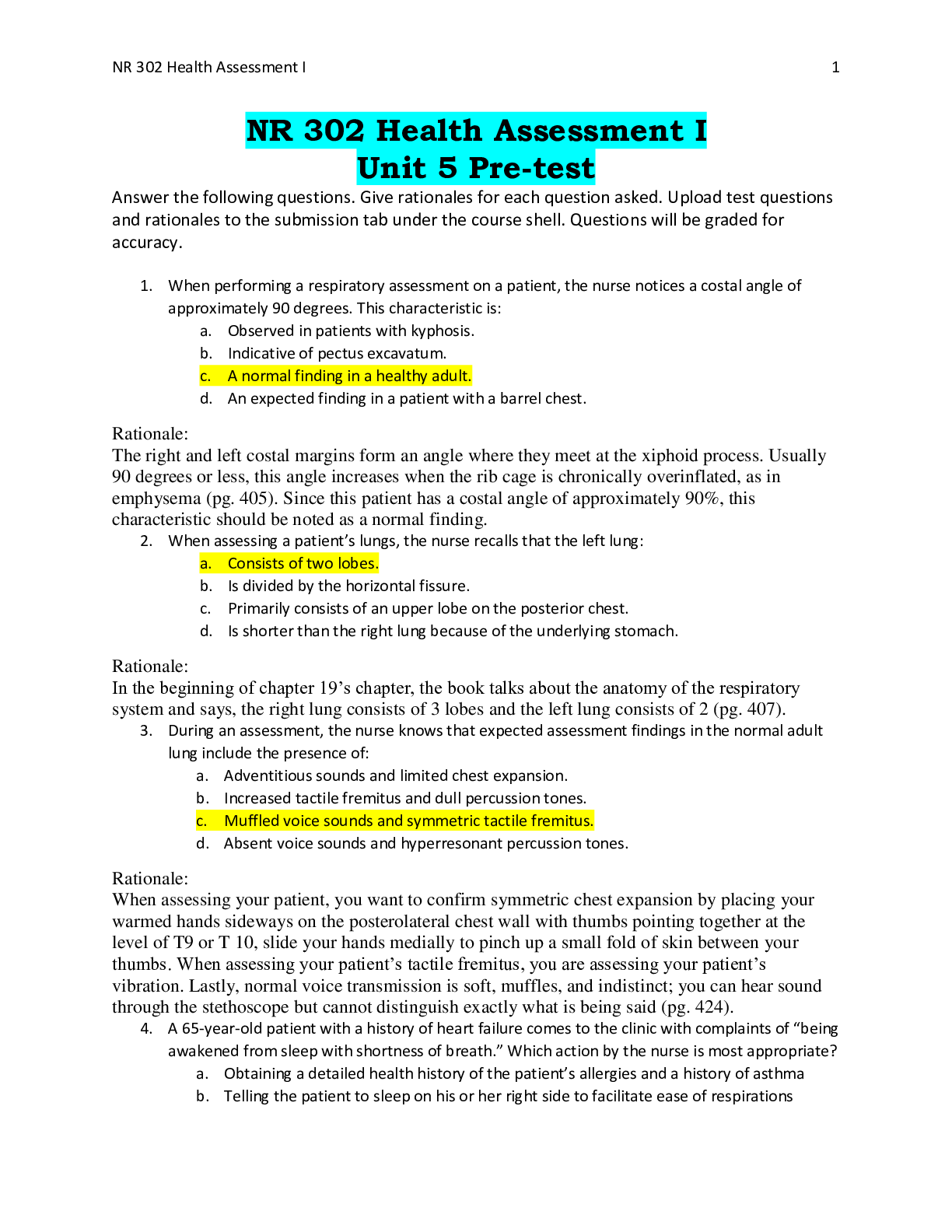
Instant download
Reviews( 0 )
Document information
Connected school, study & course
About the document
Uploaded On
May 15, 2021
Number of pages
6
Written in
Additional information
This document has been written for:
Uploaded
May 15, 2021
Downloads
0
Views
35



